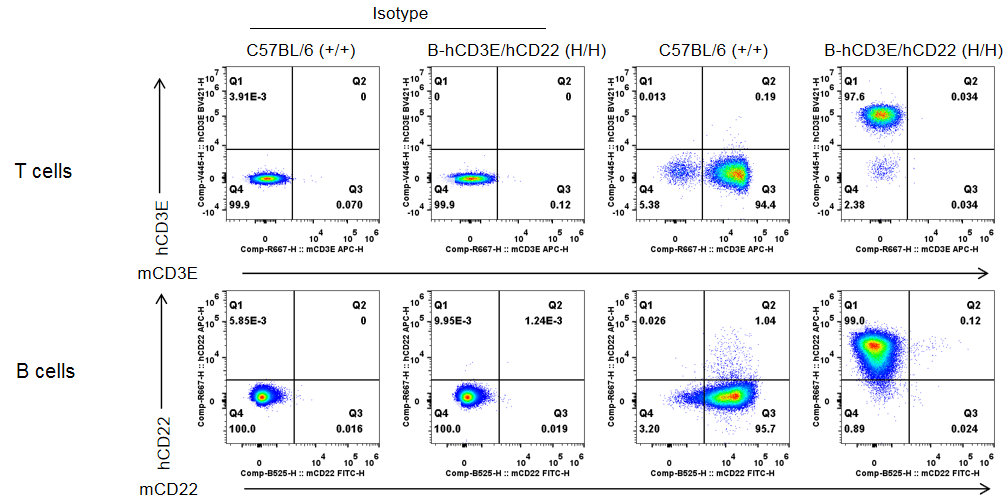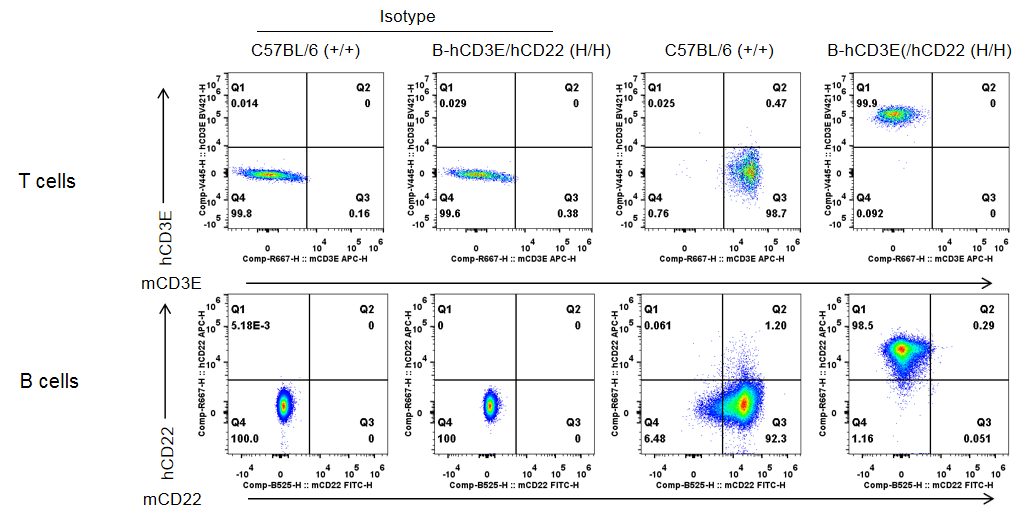


C57BL/6-Cd3etm2(CD3E)Bcgen Cd22tm1(CD22)Bcgen/Bcgen • 112609
| Product name | B-hCD3E/hCD22 mice |
|---|---|
| Catalog number | 112609 |
| Strain name | C57BL/6-Cd3etm2(CD3E)Bcgen Cd22tm1(CD22)Bcgen/Bcgen |
| Strain background | C57BL/6 |
| Aliases | CD3E (CD3E molecule);cluster of differentiation-22, SIGLEC2 |
Gene targeting strategy for B-hCD3E/hCD22 mice. The exons 2-6 of mouse Cd3e gene that encode the extracellular domain were replaced by human CD3E exons 2-7 in B-hCD3E/hCD20 mice. The exons 4-11 of mouse Cd22 gene that encode the extracellular domain were replaced by human CD22 exons 2-9 in B-hCD3E/hCD22 mice.

Strain specific CD3E and CD22 expression analysis in wild-type C57BL/6 mice and homozygous humanized B-hCD3E/hCD22 mice by flow cytometry. Splenocytes were collected from wild-type C57BL/6 mice (+/+) and homozygous B-hCD3E/hCD22 mice (H/H) (female, 8-week-old, n=1). Protein expression was analyzed with anti-human CD3E antibody (BD Horizon™, 562426), anti-mouse CD3E antibody (Biolegend, 100312), anti-human CD22 antibody (Biolegend, 363505) and anti-mouse CD22 antibody (Biolegend, 126105) by flow cytometry. Human CD3E and human CD22 was exclusively detectable in homozygous B-hCD3E/hCD22 mice, but not in wild-type C57BL/6 mice.

Strain specific CD3E and CD22 expression analysis in wild-type C57BL/6 mice and homozygous humanized B-hCD3E/hCD22 mice by flow cytometry. Blood cells were collected from wild-type C57BL/6 mice (+/+) and homozygous B-hCD3E/hCD22 mice (H/H) (female, 8-week-old, n=1). Protein expression was analyzed with anti-human CD3E antibody (BD Horizon™, 562426), anti-mouse CD3E antibody (Biolegend, 100312), anti-human CD22 antibody (Biolegend, 363505) and anti-mouse CD22 antibody (Biolegend, 126105) by flow cytometry. Human CD3E and human CD22 was exclusively detectable in homozygous B-hCD3E/hCD22 mice, but not in wild-type C57BL/6 mice.